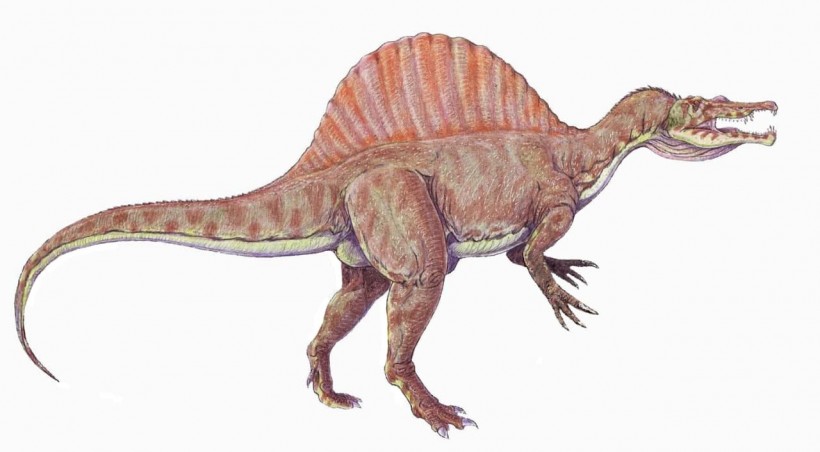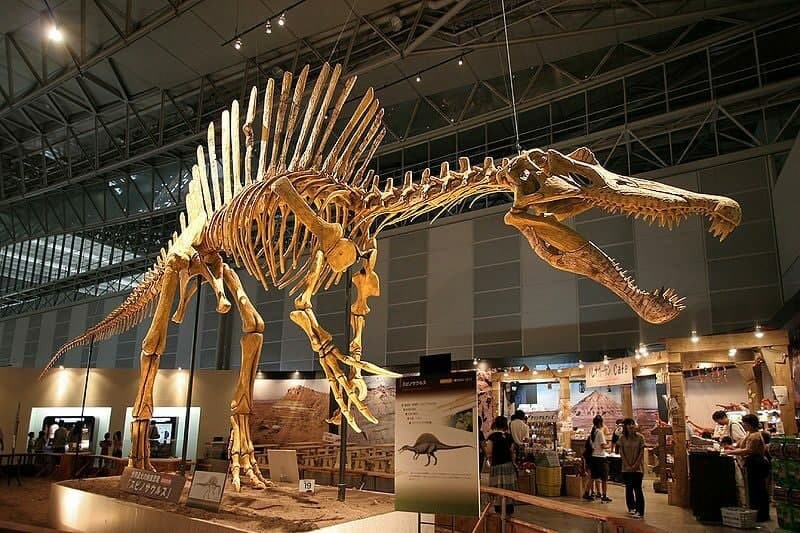If you've watched Jurassic Park III, then the image of a Spinosaurus will ring a bell. This dinosaur gained a lot of popularity following its controversial appearance in the movie franchise. Perhaps one of the scripts that triggered a lot of debates is the fact that it was portrayed as a more powerful dinosaur than Tyrannosaurus Rex, which happened to be the fans' favorite dinosaur in the previous films.
But how much do you know about the Spinosaurus? Where did it live in the Late Cretaceous period (which is about 94 million years ago)? Of course, there are a lot of speculations based on written history and stories in films. However, with tangible evidence from FossilEra.com and other credible sets of fossil researchers, we managed to compile a list of amazing facts about this carnivorous dinosaur.
1. A large sail
One feature that's quite prominent is its large sail. This dinosaur had a sail made of very long spines. The height of this sail is believed to have been about seven feet (over 1.8 meters) on average. When the animal arched its body, this part of its body would rise even higher.
So, why did it have such a long sail? There's no conclusive answer to this question, but several theories regarding the dinosaur's sail have been presented thus far. One line of thought played a role in sexual interactions. Just like a peacock's tail, it's believed that the bigger the sail, the more attractive a Spinosaurus was to the females.
The counterargument to this is the fact other dinosaurs of the Cretaceous period lacked this feature, yet it'd have played the same role. Well, evolution can sometimes be quite a capricious process, and all it takes is one ancestor with a specific feature to get the ball rolling.
Another theory is that the sail was meant for temperature regulation. During the day, the sail might have absorbed heat and radiated it at night since there would be no natural source of heat. This hypothesis is based on the fact that Dimetrodon, which existed much earlier, used its sail for this purpose.
However, the difference is that Spinosaurus was endothermic, while the Dimetrodon was ectothermic. This makes it a little bit difficult to compare the two based on heat regulation. Nevertheless, the fact remains that the Spinosaurus's sail was quite large.

2. It may have been a swimmer
If you've read a lot of history books relating to dinosaurs, then you might have noticed that one of the characteristics associated with Spinosaurus is a large tail. According to paleontologists, the tail structure may have made it a swimming dinosaur. Scientists have spent several years trying to find the pieces to reconstruct the body of this animal.
The latest report shows a large tail that resembles a giant peddle. That alone suggests that this dinosaur might have been able to swim through the waters. The Spinosaurus's tail structure is quite similar to that of a fish but, obviously, magnified.
Another theory pointing towards this conclusion is the discovery made in parts of Nothern Africa. In the 1910s, the first remains of this dinosaur were found, which marked the beginning of the never-ending puzzle. A recent discovery suggests that the Bayharia Oasis in Egypt, where the remains were found, might have been a Mangrove swamp. As such, the animals living there ought to have had certain swimming-related features to survive in such an environment.
3. Its first remains were destroyed
In 1912, Freiherr Ernst Stromer, the Bavarian paleontologist, made the discovery of a lifetime. He found the first-ever remains of the Spinosaurus; well, it was the skeleton of an unknown dinosaur at the time. Among those discovered were an enormous jaw that resembled that of a crocodile and 5-foot-tall spines suggesting a sail or a hump. Based on the reconstruction, it seemed quite similar to the already discovered T-Rex.
Stromer named this newly-found animal the Egyptian Spine Lizard or the Spinosaurus. However, his fame in the wake of this discovery was short-lived. You see, the remains discovered by Stromer were housed by a Bavarian museum headed by Karl Beurlen, a staunch Nazi supporter. Since Stromer openly criticized the Nazi party, Beurlen viewed him as an enemy in the world of politics. As such, he ignored Stromer's pleas to move the fossils to safety following the events of World War II. Unfortunately, they were destroyed by the bombing raid of the Allied forces in 1944.
4. Spinosaurus was bigger than T-Rex
To the fans of T-Rex in Jurassic Park, this might be quite heartbreaking, but research shows that Spinosaurus was bigger than T-Rex. So apart from being the first dinosaur, at least on record, to ever swim, Spinosaurus is also considered the biggest meat-eating dinosaur in the Cretaceous period.
This giant dinosaur is believed to have weighed about 10 tons, which is one ton more than the heaviest T-Rex. Giganotosaurus, on the other hand, is believed to have weighed 9.5 tons on average, which is still less than the Spinosaurus. Of course, this is based on the few remains of Spinosaurus currently being studied. So, there is a chance that there could be other bigger undiscovered Spinosaurus, which might increase the gap by a more significant margin; but that's all speculations.
Conclusion
The first remains of the Spinosaurus were found in the 1910s, but further studies on the same were put to a halt tragically after the Second World War. Recent discoveries, however, have made this dinosaur one of the most popular in the 21st century. Among its distinctive features include a huge crocodile-like jaw, a large sail, and its enormous weight of about 10 tons.
Based on this information, paleontologists now believe that the Spinosaurus might have been the biggest meat-eating dinosaur to ever roam the earth in the Cretaceous period. The record was previously held by T-Rex, but until another discovery is made, the Spinosaurus remains the most powerful carnivore of its time. Of course, to gain a better understanding of these facts, you might want to read a little bit about other dinosaurs and the current fossil studies across the globe.
© 2024 NatureWorldNews.com All rights reserved. Do not reproduce without permission.
* This is a contributed article and this content does not necessarily represent the views of natureworldnews.com



![Plastic Pollution: Scientists Include Spores of Plastic-Eating Bacteria ‘Bacillus Subtilis’ to Develop 'Self-Digesting Plastic' [Study]](https://1471793142.rsc.cdn77.org/data/thumbs/full/70396/280/157/50/40/plastic-pollution-scientists-include-spores-of-plastic-eating-bacteria-bacillus-subtilis-to-develop-self-digesting-plastic-study.jpg)


